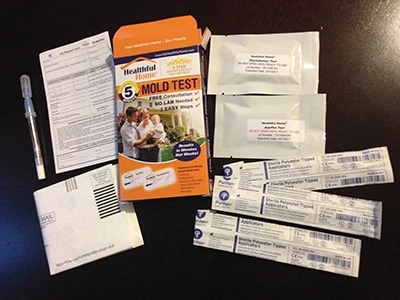The fight against mold and mildew will be an ongoing war for homeowners, not just a battle to win once and then live happily ever after. The forces of nature will inevitably give rise to the same shady, damp conditions that led to the mold growth that you abated, and you’ll have to combat it all over again.
Outdoors
Not all household cleaning products and bathroom cleansers will kill mold and mildew. One of the most commonly used products to use outside the home is diluted household bleach. Mix water with the bleach in a 3:1 ratio. Before applying the bleach, soak the surrounding plants with water.
For brick and stone, leave the bleach on the surface for 20 minutes while adding more as it dries. For wood, rinse thoroughly after 5 or 10 minutes. Scrub as necessary. Don’t allow the bleach to dry on the surface.
One problem with standard household bleach, however, is its inability to stick to vertical surfaces while treating the mold or mildew. If the bleach runs off before it kills the spores, then it isn’t doing a very effective job.
The EHT staff recently tested a new product that made application much easier—with no mixing required. Moldex Instant House Wash is formulated with new advanced bleach gel that has Active Cling Technology to hold onto vertical surfaces for the highest effective contact time.
The bleach gel also helps remove unwanted stains deep below the surface for better cleaning of porous materials.
For elevated surfaces that are hard to reach, the Moldex product also comes in a handy multipurpose applicator bottle. To use, simply attach the bottle to a garden hose while the valve is in the “Off” position and turn on the faucet. When you’re ready to apply, switch the valve to “Clean,” and the water stream will blend with the Moldex House Wash as it leaves the nozzle, enabling you to spray the mixture onto walls, fences, eaves and more. Allow the product to work for 5 to 10 minutes. Scrubbing is typically not required but may be necessary for particularly stubborn stains. Then, switch the valve to “Rinse” and use the bottle nozzle to rinse off the treated surface with fresh water. The House Wash works on vinyl, PVC, wood, composites, brick, stone, stucco, fiberglass, metal, cement and more.
Note: To protect surrounding plants, spray them with water prior to applying the product and then rinse them thoroughly after the job.
Indoors
You can expect mold and mildew outside your home because of the natural damp conditions of the outdoors. Mold and mildew inside the home is a different problem, because the inside of your home shouldn’t remain damp.
The presence of moisture is the biggest contributor to mold growth, and to fight the infestation you should conduct a room-by-room assessment of the house to identify problem areas. The moisture can come from condensation due to poor ventilation (attic), from a water leak (around bathrooms), or from outdoor intrusion (foundation walls). Once you discover mold on the home’s interior, the first step in solving the problem is to eliminate the source of moisture—whatever that may be. Otherwise, any mold or mildew you clean is likely to return.
For minor problems you may be able to clean the surface of the materials with bleach or an antimicrobial cleaner. For major problems, remove materials that cannot be thoroughly cleaned of mold and mildew, like insulation, carpeting or drywall. Use your antimicrobial cleaner to clean the surrounding area as well as the places where you actually see mold and mildew, to make sure you remove all traces of the substances.
Finally, replace the removed building materials with new, mold-free materials.
Detection
Mold and mildew in a home is not always easy to detect if it exists within attics or is hidden within walls. If you suspect your indoor air quality is hindered by hidden mold, you can conduct your own DIY test to detect a problem.
The EHT staff recently conducted the Healthful Home 5-Minute Mold Test in a finished basement that had suffered some previous flooding problems. The air seemed fine in the room, but the old moisture issues suggested that if there were to be a mold problem in the house then it was likely to occur in this room.
The test is easy to accomplish. Simply use one of the cotton swabs included with the kit to sample surface dust in the room. Soak the swab tip in the “rinse buffer” liquid (included) and then drip five drops of the liquid onto the two test strips that come with the kit. One strip is labeled Asp/Pen (Aspergillus and/or Penicillium) and the other is labeled Stachybortrys.
Test results show in as little as 5 minutes, and much like a pregnancy test you’ll either see one line (negative results) or two lines (positive).
Luckily, our home tested negative. If the test is positive, however, it does not necessarily mean you have a serious problem but that you should consider consulting a professional indoor air quality inspector or a remediation service professional. You can also have an optional laboratory analysis of your test results conducted for an additional fee.
Learn more about both of these mold-fighting products at www.moldexbrands.com and myhealthfulhome.com.











